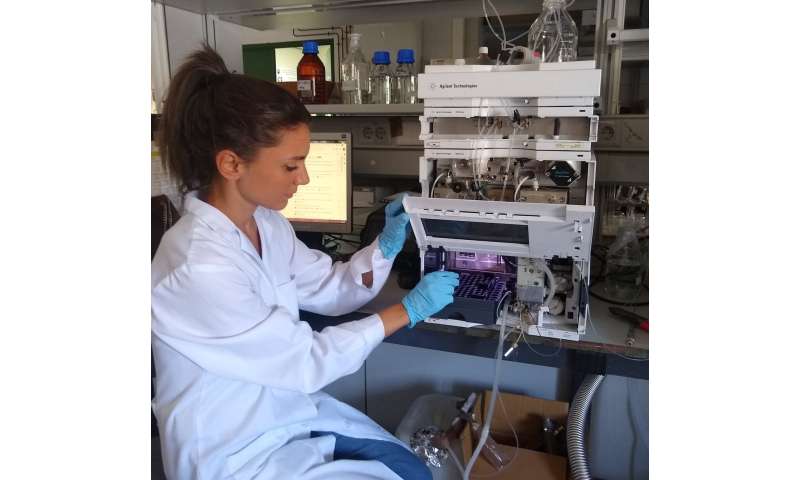New method developed to extract antibiotic residue in food from animal sources
by University of Córdoba

The researcher responsible for the study, Soledad González, in the laboratory Credit: University of Córdoba
Coccidiosis is a kind of intestinal illness that affects different groups of animals. It inhibits the absorption of nutrients and growth so that, at times, the animal dies, thus producing financial losses in the livestock industry. In order to fight this disease, antibiotics like coccidiostats are prescribed, which are effective drugs in treating the illness but that also can cause cardiovascular diseases in human beings when concentrations are high in food products from animal sources.
The Supramolecular Analytical Chemistry reseach group at the University of Cordoba developed a new method that allows for extracting and determining these substances in food from animal sources. According to the lead researcher on the study, Soledad González, the procedure is able to simultaneously extract the whole group of ionophore antibiotics (as in, those from a natural source) from all the animal source foods that are legislated in the European Union, something "done for the first time in this research project."
Specifically, the method uses supramolecular, nontoxic solvents known as SUPRAS, which have a high capacity to improve selectivity and performance of the extractions, thus lowering production costs. As pointed out by researcher Soledad González, these kinds of solvents make it possible to simultaneously extract antibiotic residue and clean the sample in a single step. What is more, "this is a low-cost, environmentally friendly method, since it uses a lower volume of organic solvent compared to other widely and routinely used techniques in laboratories," she adds.
After applying the new methodology on different products such as eggs, milk and meat (liver, kidney, muscle and fat), the detection limits that were reached were verified to be much lower than the legal limit, proving that this procedure could be applicable in food quality control laboratories. The new method has been validated following European decision 2002/657/EC, regulating the presence of residues in animal source products, so it could be incorporated into routine controls at laboratories. Researchers Ana María Ballesteros, Soledad Rubio and Diego García-Gómez also participated in this study, with García-Gómez being from the University of Salamanca.
Explore further
Coccidiosis is a kind of intestinal illness that affects different groups of animals. It inhibits the absorption of nutrients and growth so that, at times, the animal dies, thus producing financial losses in the livestock industry. In order to fight this disease, antibiotics like coccidiostats are prescribed, which are effective drugs in treating the illness but that also can cause cardiovascular diseases in human beings when concentrations are high in food products from animal sources.
The Supramolecular Analytical Chemistry reseach group at the University of Cordoba developed a new method that allows for extracting and determining these substances in food from animal sources. According to the lead researcher on the study, Soledad González, the procedure is able to simultaneously extract the whole group of ionophore antibiotics (as in, those from a natural source) from all the animal source foods that are legislated in the European Union, something "done for the first time in this research project."
Specifically, the method uses supramolecular, nontoxic solvents known as SUPRAS, which have a high capacity to improve selectivity and performance of the extractions, thus lowering production costs. As pointed out by researcher Soledad González, these kinds of solvents make it possible to simultaneously extract antibiotic residue and clean the sample in a single step. What is more, "this is a low-cost, environmentally friendly method, since it uses a lower volume of organic solvent compared to other widely and routinely used techniques in laboratories," she adds.
After applying the new methodology on different products such as eggs, milk and meat (liver, kidney, muscle and fat), the detection limits that were reached were verified to be much lower than the legal limit, proving that this procedure could be applicable in food quality control laboratories. The new method has been validated following European decision 2002/657/EC, regulating the presence of residues in animal source products, so it could be incorporated into routine controls at laboratories. Researchers Ana María Ballesteros, Soledad Rubio and Diego García-Gómez also participated in this study, with García-Gómez being from the University of Salamanca.
Explore further
More information: S. González-Rubio et al, A new sample treatment strategy based on simultaneous supramolecular solvent and dispersive solid-phase extraction for the determination of ionophore coccidiostats in all legislated foodstuffs, Food Chemistry (2020). DOI: 10.1016/j.foodchem.2020.126987
Journal information: Food Chemistry
Provided by University of Córdoba
No comments:
Post a Comment